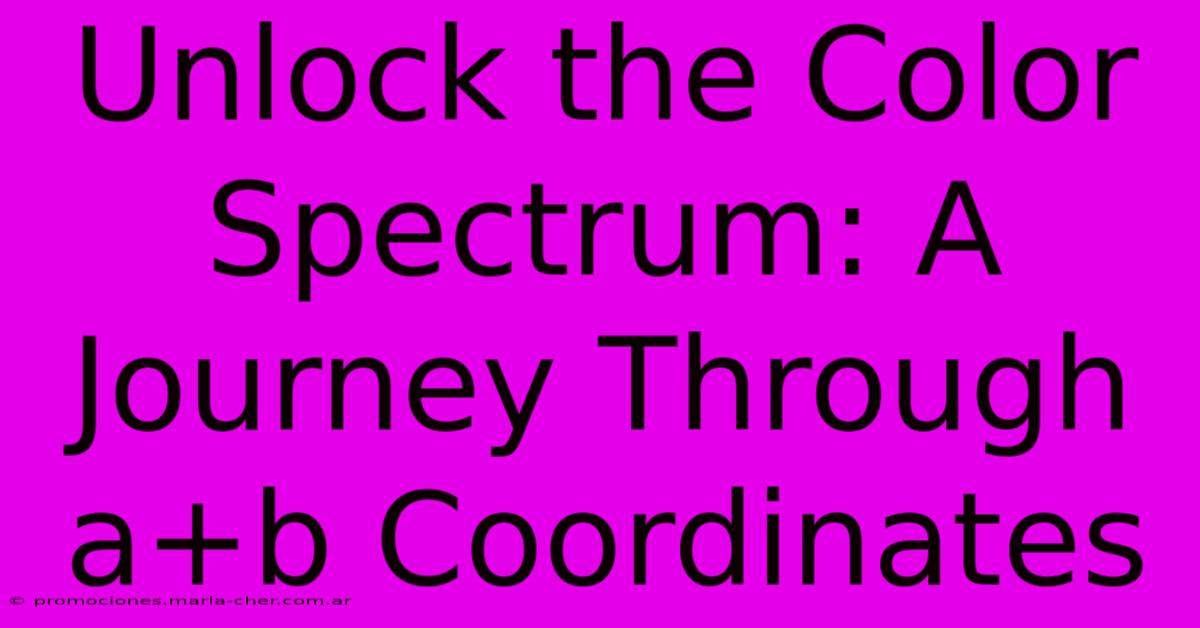Unlock The Color Spectrum: A Journey Through A+b Coordinates

Table of Contents
Unlock the Color Spectrum: A Journey Through a+b Coordinates
Understanding color can be a fascinating journey, and one of the most effective ways to navigate this vibrant landscape is through the a+b coordinate system. This system, a key component of the CIELAB color space (also known as Lab*), offers a powerful and intuitive way to describe and manipulate color, moving beyond the limitations of RGB and CMYK. This article will guide you through the intricacies of a+b coordinates, exploring their meaning, applications, and how they unlock a deeper understanding of the color spectrum.
Understanding the CIELAB Color Space
Before delving into a+b coordinates, it's crucial to understand their context within the CIELAB color space. CIELAB is a perceptually uniform color space, meaning that a small numerical difference between two colors corresponds to a small perceived difference in color by the human eye. This is a significant advantage over RGB and CMYK, which are device-dependent and don't accurately reflect human perception of color differences.
CIELAB uses three coordinates:
- L:* Represents lightness, ranging from 0 (black) to 100 (white).
- a:* Represents the green-red axis. Negative values indicate green, positive values indicate red.
- b:* Represents the blue-yellow axis. Negative values indicate blue, positive values indicate yellow.
This article focuses on the a and b coordinates**, which define the color's hue and chroma.
Decoding a+b Coordinates: Hue and Chroma
The combined values of 'a' and 'b' provide rich information about a color's characteristics beyond simple red, green, blue, and yellow. Let's break down their significance:
a Coordinate: The Green-Red Spectrum*
The 'a*' coordinate dictates the position on the green-red axis. A high positive 'a*' value signifies a reddish hue, while a high negative 'a*' value points towards a greenish hue. An 'a*' value of 0 indicates a neutral position between green and red.
b Coordinate: The Blue-Yellow Spectrum*
Similarly, the 'b*' coordinate governs the color's position on the blue-yellow axis. A high positive 'b*' value indicates a yellowish hue, whereas a high negative 'b*' value signifies a bluish hue. A 'b*' value of 0 indicates a neutral position between blue and yellow.
Understanding Hue and Chroma from a+b
By combining the 'a*' and 'b*' values, we can precisely define a color's hue and chroma. Hue refers to the pure color, while chroma represents the color's saturation or intensity. A higher absolute value of 'a*' and 'b*' will generally result in a more saturated color. Visualizing 'a*' and 'b*' on a chromaticity diagram provides a clear representation of hue and saturation.
Applications of a+b Coordinates
The power of a+b coordinates lies in their practical applications across various fields:
- Color Management in Printing and Design: Ensuring accurate color reproduction across different devices and printing processes.
- Quality Control in Manufacturing: Maintaining consistent color in products like paints, textiles, and plastics.
- Food Science: Analyzing and controlling the color of food products.
- Image Processing and Editing: Precise color adjustments and manipulations in software.
- Medical Imaging: Analyzing color variations in medical scans.
Exploring the a+b Color Space Practically
Understanding the a+b coordinate system is best achieved through practical experience. Many color management tools and software programs allow you to visualize and manipulate colors using CIELAB values. Experimenting with different 'a*' and 'b*' combinations will provide a hands-on understanding of their impact on color.
Conclusion: Mastering the a+b Spectrum
The a+b coordinate system, a crucial aspect of the CIELAB color space, offers a robust and intuitive method for understanding and manipulating color. By grasping the relationships between 'a*' and 'b*' coordinates and their influence on hue and chroma, you can unlock a deeper appreciation of the color spectrum and its applications in various fields. So, embark on this vibrant journey, explore the possibilities, and master the art of color using a+b coordinates!

Thank you for visiting our website wich cover about Unlock The Color Spectrum: A Journey Through A+b Coordinates. We hope the information provided has been useful to you. Feel free to contact us if you have any questions or need further assistance. See you next time and dont miss to bookmark.
Featured Posts
-
The Art Of The Email Disconnect Signature Slogans To Send With A Wink
Feb 10, 2025
-
Revolutionize Your Art How 12 X 18 Canvases Ignite Your Creativity
Feb 10, 2025
-
The Ultimate Guide To Exploring Cobo Hall Detroit Beyond The Exhibits
Feb 10, 2025
-
Unveiling The Great Lakes Museums New Webcam An Immersive Virtual Experience
Feb 10, 2025
-
Mermaid Manicures Redefined Dnds Gel Polish Collection Takes You Under The Sea
Feb 10, 2025
